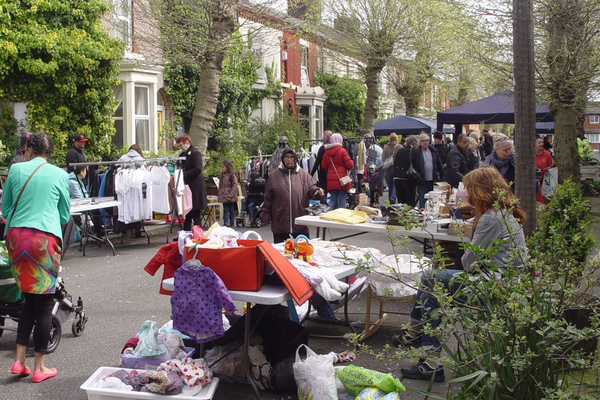Candidate: Cairns Street
Location: Liverpool, UK
Category: The Great Street Award
Year: 2016
Learning Moments
1. Bottom-up vs. top-down
Determined community action is winning out where official approaches failed. “Bottom up convincing top down.” Planting and street market have created opportunities for positive conversations that could not happen otherwise. The outcomes of these are bringing the community back together, including former residents.
2. Artists add value (not cost)
Creative engagement with artists delivers value way beyond its direct cost. Assemble – the Turner Prize-nominated architects / artists – have created a community enterprise with local a local training dimension.
3. The grey economy facilitates action
A local resident (rag & bone man) brings resources, which are freely donated, including picnic tables, household goods, etc. This has enabled the community to function without using valuable grant aid.
Assessment Summary
This Victorian tree-lined terraced street is being regenerated in a most remarkable way due to the determination of local residents.
Cairns Street sits within the Granby Triangle, an area subject to clearance plans for decades through various government programmes. Residents who remained believed that their streets were worthy of restoration and eventually formed a community land trust (CLT). They have worked tirelessly to ensure the future of their homes and streets.
Historically, the area was racially and culturally mixed, with a high proportion of BME (black and minority ethnic) residents. It gained notoriety during the Toxteth riots in 1981. The continuous emptying of properties for clearance led to a serious decline in population and increasing dereliction. Until now official interventions have all failed.
Over the last 5 – 10 years a small group of remaining residents initiated a programme of direct action and started to clean up the street, plant shrubs and flowers, and paint the hoardings on empty homes. They were attempting to change the perception of the place and encourage outsiders to see it as a community that cared. Furthermore, they set up a street market in Cairns Street which, in addition to the obvious economic benefits, has brought people back into the neighbourhood. These actions have inspired former residents to return and newcomers to consider moving into this residential urban enclave close to the city centre.
With various forms of voluntary support residents were able to formalise themselves into a CLT which has acquired some properties at a peppercorn price to carry out the renovation that they always believed was the right solution to regeneration.
The trust has also worked with the council to regenerate the four streets making up the neighbourhood and currently there are 47 homes being renovated or reconstructed through the trust and local housing associations. During the current construction stage the CLT runs a cafe for building workers with volunteers and continues to host the monthly market.
Assemble, a young architecture practice working for the CLT, is pushing the creative boundaries to bring stylish, lower-than-market-cost renovation schemes forward for 10 houses. Five of these will be for rental and five for sale under a shared equity scheme. The designs have cost-effectively re-imagined spaces within the terraced houses and one pair of terraces, too derelict to restore, are being earmarked for a winter garden.
In addition to the house renovations, a great deal of complementary action is helping to regenerate the community itself. Perhaps the most interesting is the involvement of artists. Assemble and Will Shannon have worked with local people to devise a small range of products that can be used in the renovation schemes. This has led to a training workshop being established in a former corner shop for local, particularly young, unemployed people to provide apprenticeship training in the making of products (e.g. designs for ‘smoked’ porcelain door knobs and also terrazzo-style mantelpieces made from recycled demolition materials) which are expected to have a wider market. Perhaps the most remarkable recognition for the overall project is that Assemble has been nominated for the Turner Prize. The residents are creatively exploiting this opportunity to ensure that the project as a whole benefits from the associated publicity.
Thus regeneration is being achieved through a creative balance of this “bottom-up; top-down” approach. It is delivering added value in local economic and social capital which underpins the physical building work. Local people still claim that the planting and clean-up process that kick-started the initiative in the face of the threat of demolition remains the most important aspect of the project as it brings people together in the public domain, beautifies the area and ensures it is cared for by visitors and residents. This is an accessible process in which everyone can engage with collectively at little cost with maximum impact.
These initiatives have attracted other investors in the immediate area too: Liverpool City Council is supporting “Homes for a Pound” which does just that if owners commit to at least £35,000 of refurbishments; Plus Dane Housing Association, Liverpool Mutual Homes and Terrace 21 are also renovating homes and building new build replacements.
Whereas the Cairns Street regeneration process is far from complete, all of the ingredients for a great street are in place and hopefully the regeneration process will continue to flourish. Ultimately, Cairns Street is more about the people constructing a resilient community than the renovation and construction of houses. However, the spirit of the street is evident now.









